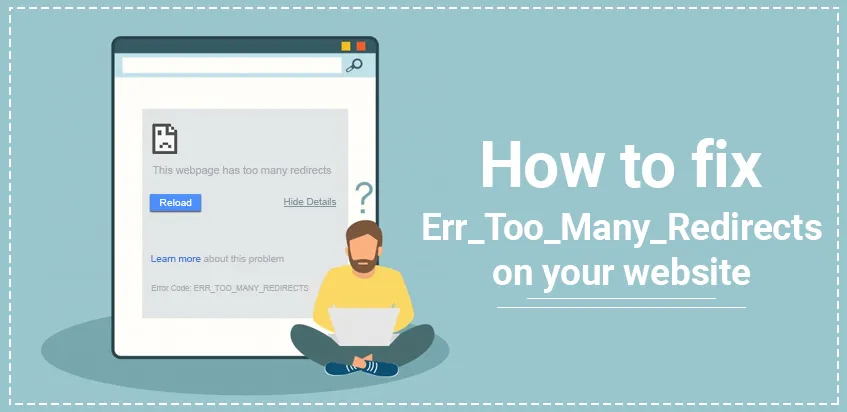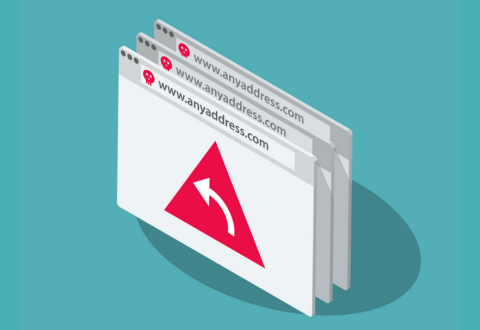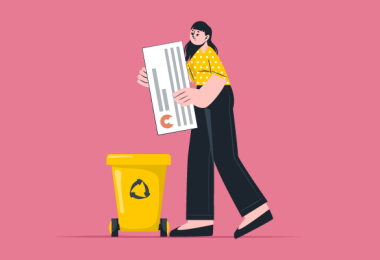When navigating to an Internet page, the user may encounter a sudden “ERR_TOO_MANY_REDIRECTS” message in the browser window, which often contains an error code 310. This error occurs when the browser gets involved in a “bad infinity” ofredirects from one page to another with error 310. Let’s take a look at the causes of this problem, and the solutions.
- What does ERR_TOO_MANY_REDIRECTS mean?
- Why are you getting this error?
- Solution one: delete cookies on this particular site
- Solution two: Clear server, proxy and browser cache
- Solution three: Troubleshooting plugins
- Solution four: Resetting the .htaccess file
- Solution five: Check URLs
- Solution six : reconfigure the security protocol
- Conclusion
What does ERR_TOO_MANY_REDIRECTS mean?
This error message is an infinite loop. It means that website A wants to access website B via a link. Only this website B immediately redirects back to page A. The website is stuck in a call loop, a vicious cycle also known as a redirection loop.
A message box is created when the browser interrupts this loop after noticing that the path no longer continues. It reports, “This page is not working”. At the same time, this means that it is not the web server that detects the error, but only the browser that intercepts it.
The ERR_TOO_MANY_REDIRECTS error message in WordPress may confuse the user, but it is only a warning from the browser that the requested page cannot be accessed.
If you detect an ERR_TOO_MANY_REDIRECTS message when trying to load your site, it means that part or all of the page content is inaccessible to both you and your audience.
Although it seems serious, the error is easy to fix, and you should do it as soon as possible so that your site users wouldn’t have a negative experience and leave before they recognise your content.

Why are you getting this error?
Redirects are developed on the Internet as an effective SEO (search engine optimisation) strategy or simply to make a page accessible via a different URL.
Suppose you create a website with great relevance, but for some reason instead of updating the content you prefer to direct the user to a new landing page, more complete or with different features.
It would be inconvenient to ask the user to click or type a new URL in the address bar.
With redirection, you can access this new page from the old address, but automatically, to improve the user experience.
However, there are cases where redirects are misconfigured and instead of the old page leading to the new page, this may lead to different URLs or to a path that the browser does not recognise.
When the browser does not understand or know which URL to follow so as not to reload, it stops trying to find the correct page and gives the user an “ERR_TOO_MANY_REDIRECTS” error.
In very specific cases, the browser introduces an endless cycle of redirects.
The old page is redirected to the new page, but due to misconfiguration, the new page is also redirected to the old page, and this happens continuously until the browser stops displaying the page and displays the ERR_TOO_MANY_REDIRECTS message.
Solution one: delete cookies on this particular site
Cookies are probably the most common problem with user-side redirection cycles. How can this happen?
- Cookies are not deleted: you visit a website and log in. You click on the website and go to view the checkout. The cookie is retained. For example, if you leave the website without first logging out, the cookie cannot be deleted.
- The cookie has an “invalid status”: you will want to log in again in subsequent days. But the saved cookie in your browser still wants to redirect you to the checkout, which you can only reach in the system.
- Endless loop: Once you are in the login window, the cookie starts forwarding. The website notifies you that you are not logged in to view the checkout. So it goes back to the login. However, once there, the cookie is still active and wants to return you to checkout…
Solution: In your browser settings you must delete the cookie. This will interrupt future redirection cycles. And the ERR_TOO_MANY_REDIRECTS error is no longer displayed. At least until the next cookie is incorrectly deleted.
Solution two: Clear server, proxy and browser cache
Due to the fact that redirection loops are responses that can be cached, it is always advisable to try and clear the cache on your WordPress site, server, third-party proxies and even your browser if necessary.
- Clear the cache from your WordPress site
Using cache software can inadvertently store states that can lead to endless loops. In WordPress, these are cache extensions such as aswp-Rocket, W3 Total Cache or Super Cache. The cache may still display an error, even if the actual cause has already been fixed. A simple administrator login to the CMS or cache system in use, such as Cloudflare, and deleting the cache via settings is the solution here.
The web server cache may also have stored the wrong state. For this, you need to log in through your hoster to clear the cache directly on the server.
- Clear proxy cache
If you use a third-party reverse proxy service such as Cloudflare or Sucuri, it can also be useful to clear the cache on your side.
- Clear your browser cache
If you want to check and see if your browser cache is faulty without clearing the cache, you can always open your browser in incognito mode. Or try another browser and you’ll see that the ERR_TOO_MANY_REDIRECTS error is still displayed.
Get 7 days free trial access to all tools.
No credit card needed!

Solution three: Troubleshooting plugins
A WordPress plugin can always be the source of a problem. If you have a redirect plugin installed, start by disabling it.
If that works, great. If not, you’ll have to disable the installed plugins one by one to check which one caused the error.
There is a very practical way to check if this is indeed the problem: first disable all plugins at once before reloading the page.
If the error persists, activate all the plugins again and go to the next step. If on reloading the site you are satisfied that the problem has been resolved, you will have to try one by one.
If ERR_TOO_MANY_REDIRECTS does not allow you to access the configuration panel, you will have to disable the plugins manually, via FTP or file manager:
Find the WordPress plugins folder, which is in the wp-content folder (where WordPress was installed).
Rename the folders of each plugin.
Or delete all plugins at once (don’t forget to back them up).
Solution four: Resetting the .htaccess file
The .htaccess file should always be handled in case of WordPress errors. It is related to the Apache server configuration and is used to manage even the page redirection configuration.
Thus, any problem with the .htaccess file can lead to errors in this procedure.
You will have to reset the .htaccess file to find out if this is the problem:
- Access the files on the site using an FTP client.
- When you are logged in, find the folder containing the WordPress files.
- In this folder find the .htaccess file.
- Download the file as a backup.
- Right-click and open the file to edit it (never edit the backup, but the file on the server).
- Clean up the contents of the .htaccess file and replace it with the default configuration (it can be easily obtained online).
- Save and upload this default file to your web server.
- Once the upload is complete, refresh the site.
If the error is fixed, this means you will have to review the configuration of the .htaccess file.
Solution five: Check URLs
In the well-known content management system (CMS) WordPress, faulty page URLs can cause a redirection cycle. To do this, open your installation settings. Under General, you will find your WordPress address and website address.
If your WordPress installation was not installed in a sub-folder on the web server, both addresses should be the same. Ifthey are not, copy the WordPress address into the website address field.
However, there are also a number of hosts that do not provide this configuration option for security reasons. There are two possibilities:
- Option 1: To make changes anyway, it helps to access the database.Connection to the database can be established via phpMyAdmin (or a similar MySQL client). URLs in the wp_options table can be edited manually. Be careful not to make any mistakes here, as a wrong step may cause the whole page to stop working. Pre-backup of the database is recommended in any case!
- Option 2: It is also possible to change the configuration file wp_config.php. This is located in the main WordPress installation directory. The following two lines should be integrated (with the website URL, of course):
define(“WP_SITEURL”, “https://example.com”);
define(“WP_HOME”, “https://example.com”);
Make sure the two addresses are identical and save the file afterwards.
solution six : reconfigure the security protocol
If you are using the security protocol (SSL certificate), change it to the normal protocol (HTTP), reload the page and check if the error is corrected.
If the error does not show up, it means that your SSL certificate must be configured correctly before you can use it again (address set to https).
Remember to seek help from an expert or forum to resume the configuration, which will guarantee secure access for your users. This will also be important for the reliability of your site.

Solution six : reconfigure the security protocol
If you are using the security protocol (SSL certificate), change it to the normal protocol (HTTP), reload the page and check if the error is corrected.
If the error does not show up, it means that your SSL certificate must be configured correctly before you can use it again (address set to https).
Remember to seek help from an expert or forum to resume the configuration, which will guarantee secure access for your users. This will also be important for the reliability of your site.
Conclusion
The redirect cycle has many different sources. Looking closely at your own settings, whether as a user or as webmaster, can help. Unfortunately there’s no simple generic solution to control endless loops during redirects and redirects. It is therefore important to have this guide ready if unwanted ERR_TOO_MANY_REDIRECTS messages appear again.







thanks!